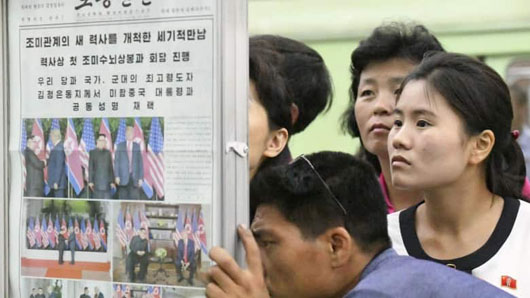by WorldTribune Staff, June 14, 2018
North Korean state media has adjusted its attitude toward U.S. President Donald Trump in its post-summit coverage.
Previously, the U.S. president had been referred to only as “Trump”, with no honorifics or signs of respect, Associated Press Pyongyang bureau chief Eric Talmadge noted in a June 14 report.

At the Singapore summit, Trump was seen shaking hands with Kim Jong-Un “and even awkwardly saluting a three-star general. It’s a far cry from the ‘dotard’ label their government slapped on him last year,” Talmadge wrote.
Following the summit, North Korean media are now referring to Trump as “the president of the United States of America,” or “President Donald J. Trump” – and even “supreme leader.”
“The post-summit transformation of North Korea’s official version of Trump, who’s now being shown by state media looking serious and almost regal, underscores the carefully choreographed reality show the government has had to perform to keep its people, taught from childhood to hate and distrust the ‘American imperialists,’ ideologically on board with the tectonic shifts underway in their country’s relationship with Washington,” Talmadge wrote.
The North’s state-run television aired its first videos and photos of the summit on two days after the event and a full day after Kim returned home to Pyongyang.
“To be sure, the star of the show was Kim,” Talmadge wrote. “Trump’s first appearance and the now famous handshake didn’t come until almost 20 minutes into the 42-minute program.”
The program “depicted Kim as statesmanlike beyond his years, confident and polite, quick to smile and firmly in control. He was shown allowing the older American – Trump, in his seventies, is more than twice Kim’s age – to lean in toward him to shake hands, or give a thumbs up, then walking a few steps ahead to a working lunch.”
Before showing Trump and Kim signing their joint statement, the newscaster said Trump “made a point of giving Kim a look at his armored Cadillac limousine, and noted that it is known to Americans as ‘the Beast.’ She also at one point called them the ‘two supreme leaders’ of their countries,” Talmadge noted.
Talmadge continued: “The state media’s representation of the summit and Trump is extremely important because it gives the North Korean population, which has only limited access to other news sources, an idea not just of what’s going on but also of how the government expects them to respond.”
Meanwhile, Secretary of State Mike Pompeo on June 14 said the U.S. has not dropped the aim of denuclearizing North Korea and that Kim Jong-Un understands he must denuclearize “quickly.”
“The sequence will be different this time,” Pompeo said during a joint press conference with South Korean Foreign Minister Kang Kyung-Wha and Japanese Foreign Minister Taro Kono. The U.S. and its key Asian allies remain “committed to achieving the complete, verifiable and irreversible denuclearization (CVID) of North Korea.”
“We believe that Chairman Kim Jong-Un understands the urgency of the timing of completing this denuclearization and understands we must do this quickly,” Pompeo said, “And the sanctions relief cannot take place until such time as we have demonstrated that North Korea has been completely denuclearized.”
Kono said, regarding the possibility of North Korea-Japan talks, that Prime Minister Shinzo Abe is willing to resolve the issue of Japanese nationals abducted by the North through “various channels and routes.”
“If the leaders meet, we need to have a summit meeting that leads to a resolution of the issue and we will coordinate going forward,” Kono said.
Subscribe to Geostrategy-Direct __________ Support Free Press Foundation
